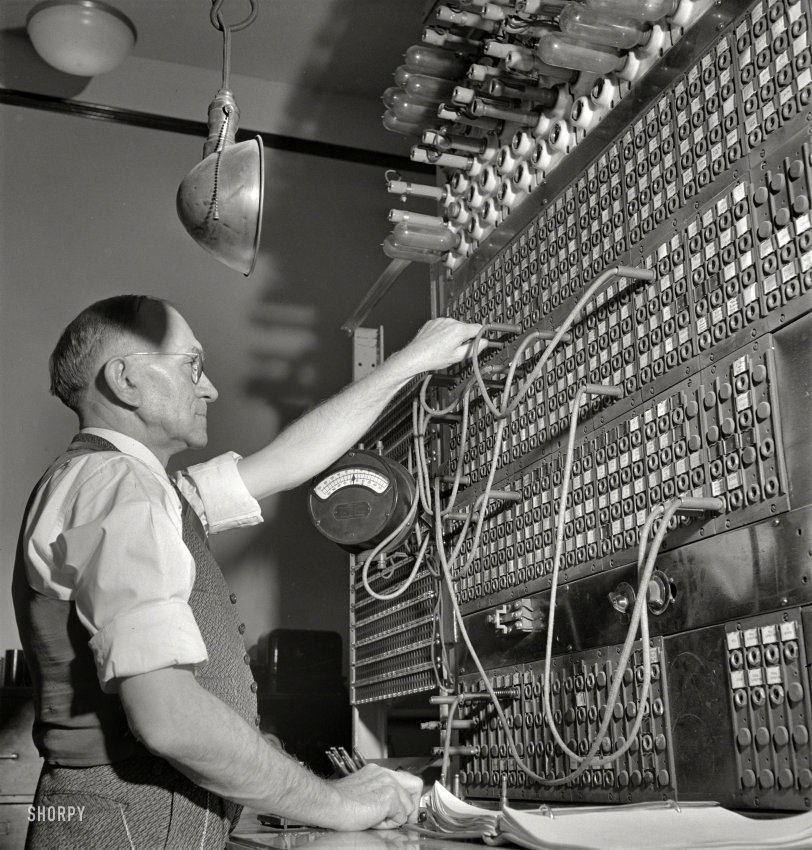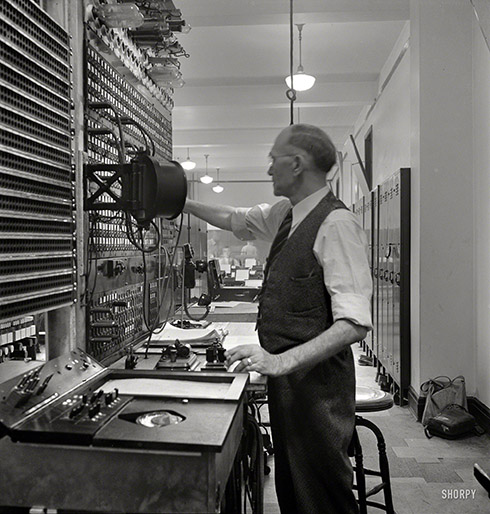


Framed or unframed, desk size to sofa size, printed by us in Arizona and Alabama since 2007. Explore now.
Shorpy is funded by you. Patreon contributors get an ad-free experience.
Learn more.

- Tough Guys
- Lost in Toyland
- And without gloves
- If I were a blindfolded time traveler
- Smoke Consumer Also Cooks
- Oh that stove!
- Possibly still there?
- What?!?
- $100 Reward
- Freeze Frame
- Texas Flyer wanted
- Just a Year Too Soon
- WWII -- Replacing men with women at the railroad crossing.
- Yes, Icing
- You kids drive me nuts!
- NOT An Easy Job
- I wonder
- Just add window boxes
- Icing Platform?
- Indiana Harbor Belt abides
- Freezing haze
- Corrections (for those who care)
- C&NW at Nelson
- Fallen Flags
- A dangerous job made worse
- Water Stop
- Passenger trains have right of way over freights?
- Coal
- Never ceases to amaze me.
- Still chuggin' (in model form)
Print Emporium
Telegraph Switchboard: 1943

January 1943. "Chicago Union Station. Telegraph switchboard of the Pennsylvania Railroad." Continuing our tour of Union Station. Medium-format negative by Jack Delano for the Office of War Information. View full size.
Down time?
Do you think this guy ever had a chance to sit for longer than 3 seconds?
Railroad Technology
This is a good example of how and why railroads were, for various reasons, especially susceptible to "technological inertia," even the mighty Pennsylvania, which billed itself as the "Standard Railroad of the World."
In Dave's alternate view, we can see that PRR already had a modern "company dial" PBX telephone system in place (there's one hanging right next to the telegraph board.) But they had so much invested in telegraph infrastructure, and it still worked perfectly well, so why throw it out?
It wouldn't be long, though, until the old telegraph equipment started getting junked. In many cases, some of the telegraph lines were converted over to its technological first cousin, the teletype. Western Union also was converting over to a teletype system, and as their need for lines decreased, they would turn to more leasing of railroad pole space. Huge advances were being made in telephony (Bell Labs was about to perfect the transistor), and quantum leaps in line-carrying capacity made all those old circuits redundant. Few people remember that that was how Thomas Edison got his start, duplexing and multiplexing telegraph circuits in order to increase line capacity. I believe the majority of Edison patents were related to telegraphy.
Tubes and Bulbs
What are those for at the top of the board?
It's a test board
I suspect you are looking at a telegraph test board rather than switch board. It would be used to test telegraph & teletype circuits and the associate equipment. The patch board allowed faulty terminal equipment and circuits to be replaced by patching spare equipment or circuits in their place. The meter was used to adjust the voltages on equipment – both positive and negative voltages were used on telegraph circuits.
Fast Forward to the 21st Century
Now we know what it looks inside of today's microchips.
Even then, an antique
It's funny, when you find old terminal equipment like this today, and it has that patina of dust and grime and corrosion, you think to yourself, "Gee, if we could only see a picture from, say, 1943, when it was all shiny and new."
That's a lesson I've learned from almost every old technology photo on Shorpy: none of the pictured equipment was ever brand new. Even in a hundred-year-old photo, most equipment already looks decrepit.
Alternate View
Instruments
I'd say that is a sounder. Key would certainly be on a level surface, and this fellow was probably not primarily a telegrapher; he seems responsible for making connections between stations.
The big meter is interesting. Center zero, indicating ± 200 in some units. I'd guess milliamps through a closed telegraph circuit. Since the power supply (batteries) could be at either end off the line, the current could flow either way.

The big gauge
Imagine, every one of those little white tags is in this man's head. A real pro from the look of it. Does anyone know what that big gauge indicates? Neat little key on the board in front of him - or is that a sounder?

























On Shorpy:
Today’s Top 5